Rhubarb Custard Tart with Orange and Vanilla
This rhubarb custard tart features creamy orange, vanilla custard, and roasted rhubarb in a flaky shortcrust pastry case. It’s easy to put together and makes a stand-out dessert. The rhubarb tart filling is a creamy orange and vanilla-scented custard.
On this, bright pops of roasted rhubarb pieces and candied orange peel sit nestled in the custard. It’s encased in a flaky, all-butter shortcrust pastry shell.
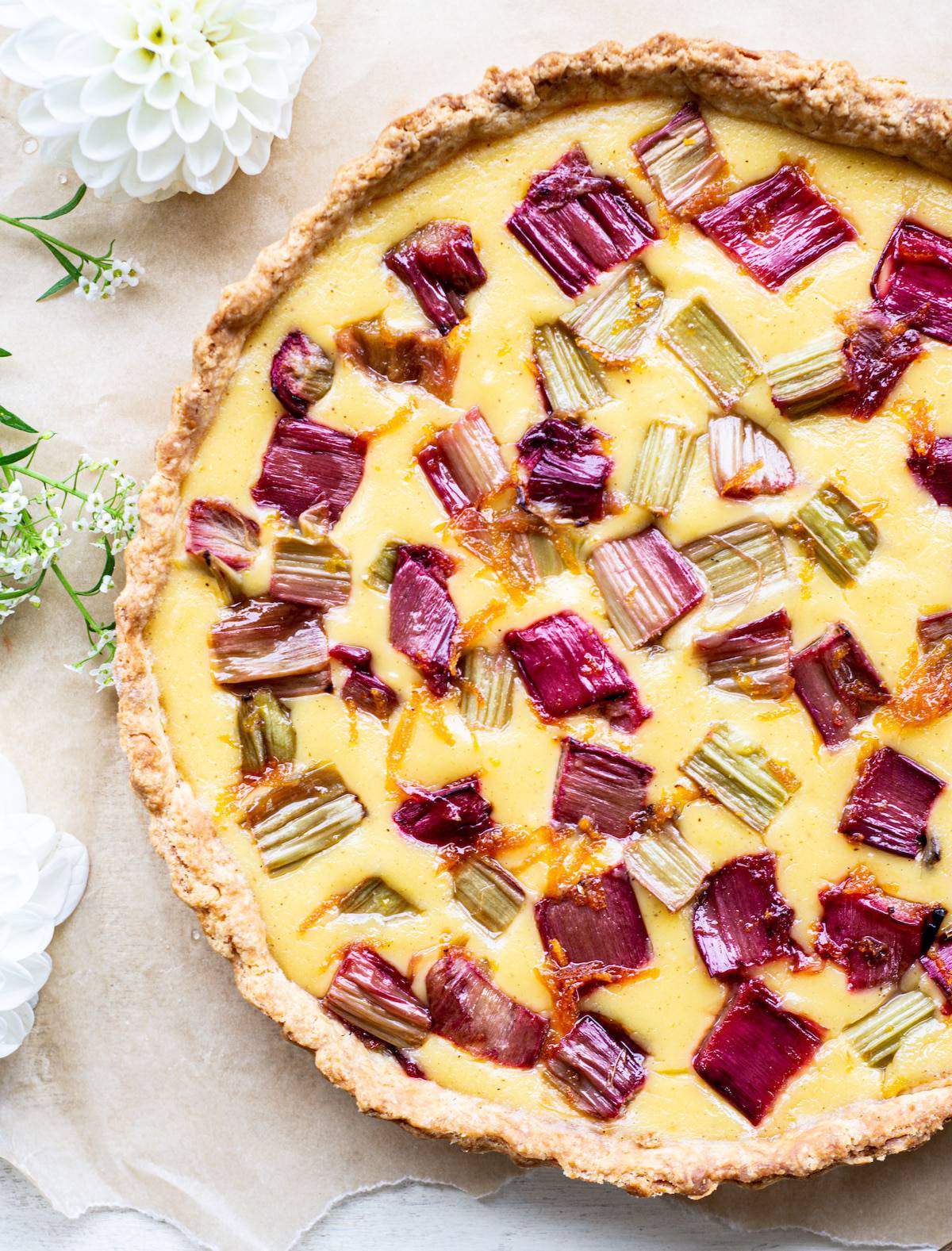
Shortcrust pastry
This is a flaky and sweet shortcrust pastry, bound with egg and milk for extra richness and flavor.
A basic shortcrust pastry is one with a fairly high ratio of fat to flour. The exact amounts change depending on each pastry recipe but often the amount of fat is about 50% of the total amount of flour. The more fat in the mix, the flakier the pastry will be, however, the more fat added also means the pastry can become difficult to work with.
A basic shortcrust pastry usually consists of flour, fat, and liquid to hold it together. This pastry can be used for sweet and savory dishes, though in sweet dishes the shortcrust pastry benefits from having a little sugar and egg added in as well.
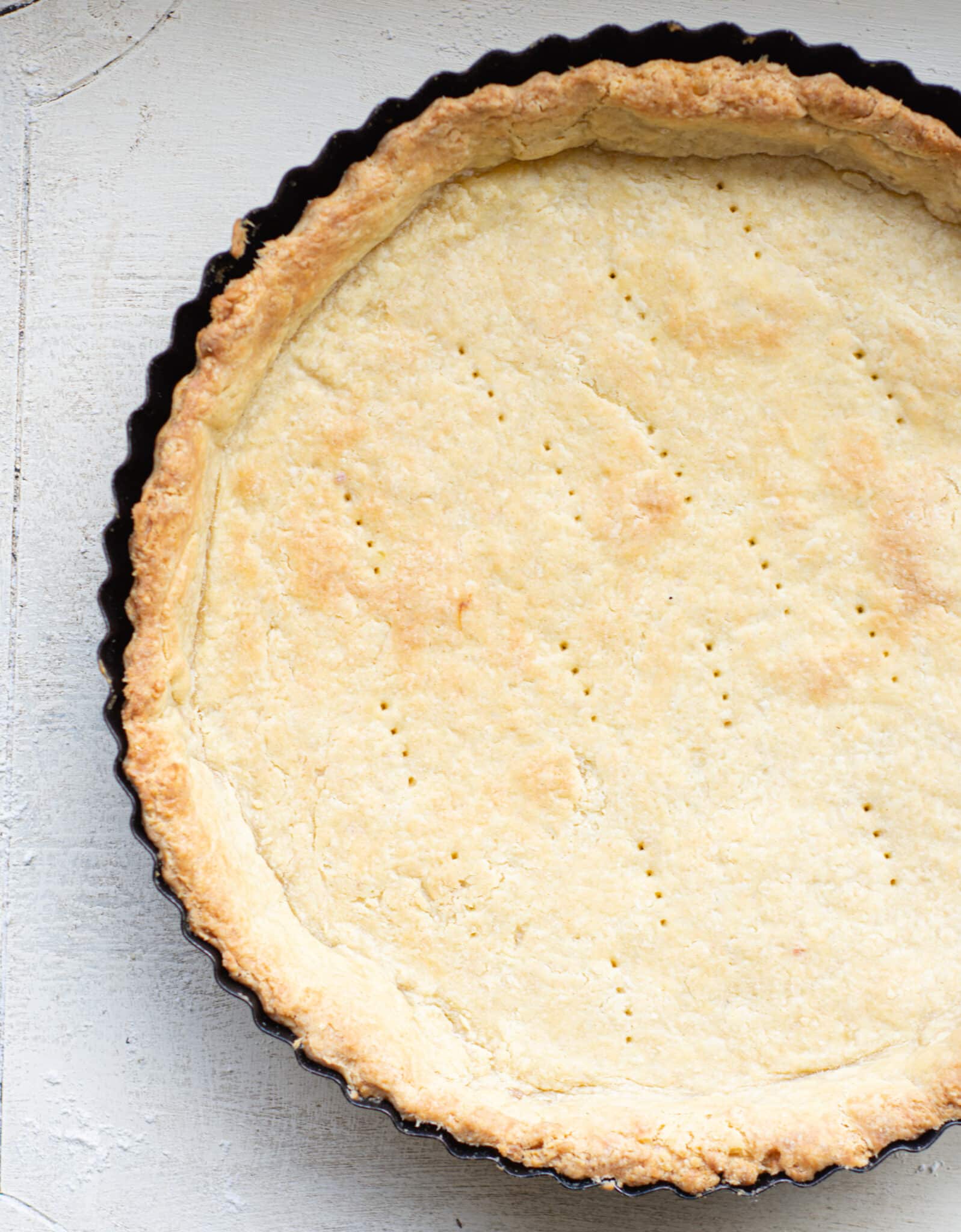
Shortcrust pastry flour
The flour needed in a shortcrust pastry can be all-purpose though for best results it should be fairly low in gluten. All-purpose flour protein levels can vary between brands, and the name of the flour itself can vary between countries. It’s best to check protein levels rather than just the name of the flour.
Flour with a protein level of around 10% works well in this pastry. Using flours with a higher protein can create a tougher pastry case and cause the pastry shell to shrink in the oven.
The aim of making shortcrust pastry is not to develop the gluten and create strength the way that is done in bread. In shortcrust pastry, a minimal amount of liquid is added, and very little kneading is done to slow gluten development. This creates a tender pastry shell. If the pastry is overworked or too much liquid is added it can become tough and chewy.
The butter
This is an all-butter shortcrust pastry. Butter provides richness and flavor, and if handled correctly, it will give wonderful flaky layers.
The key is to keep the butter cold throughout the pastry-making process. The butter will be cut into small pea-sized pieces into the flour so that each little piece of butter can be coated in flour. It’s important that it never melts into the dough while it is being handled. When the pastry is later baked, the cold butter melts in the oven and will create flaky layers in the pastry.
The amount of butter in this recipe is a little less than 50% of the flour, because this pastry recipe has the addition of egg. The egg brings fat to the dough as well.
The method
Food processor
Combine the flour, sugar, salt, and cold butter cubes in a food processor. Pulse it until it resembles coarse breadcrumbs.
In a bowl, whisk the egg. Slowly drizzle the egg into the food processor and pulse until it forms a stiff dough. If it is too dry and crumbly add a splash of milk as needed. The end dough should hold together easily but it shouldn’t be very sticky.
Pastry by hand
In a large bowl add the flour, sugar, and salt and stir them together. Chop the cold butter into small cubes and add the cubes in. Use a pastry cutter to further cut the butter into the flour, until it resembles coarse bread crumbs. If at any point the butter begins to melt, place the bowl in the fridge or freezer to cool it down.
In a bowl, lightly whisk the egg. Make a well in the middle of the flour mixture and add in the egg. Use a fork to combine it into a stiff dough. If it is too dry and crumbly add in ½ Tbsp milk as needed.
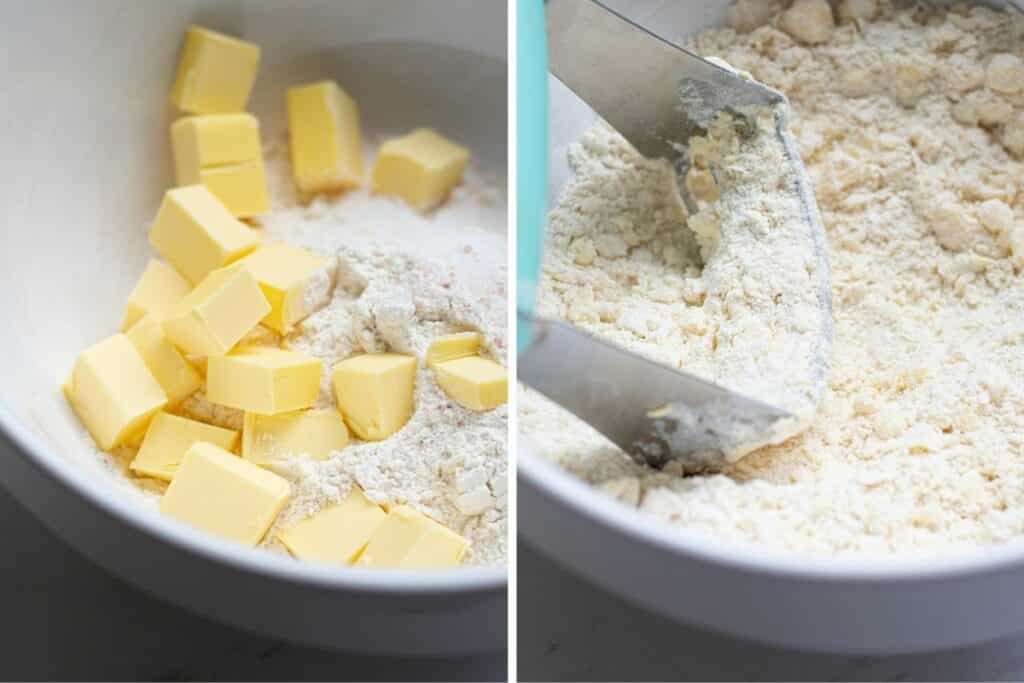
Tip the dough onto a lightly floured bench and gently form it into a disc. Don’t over knead it.
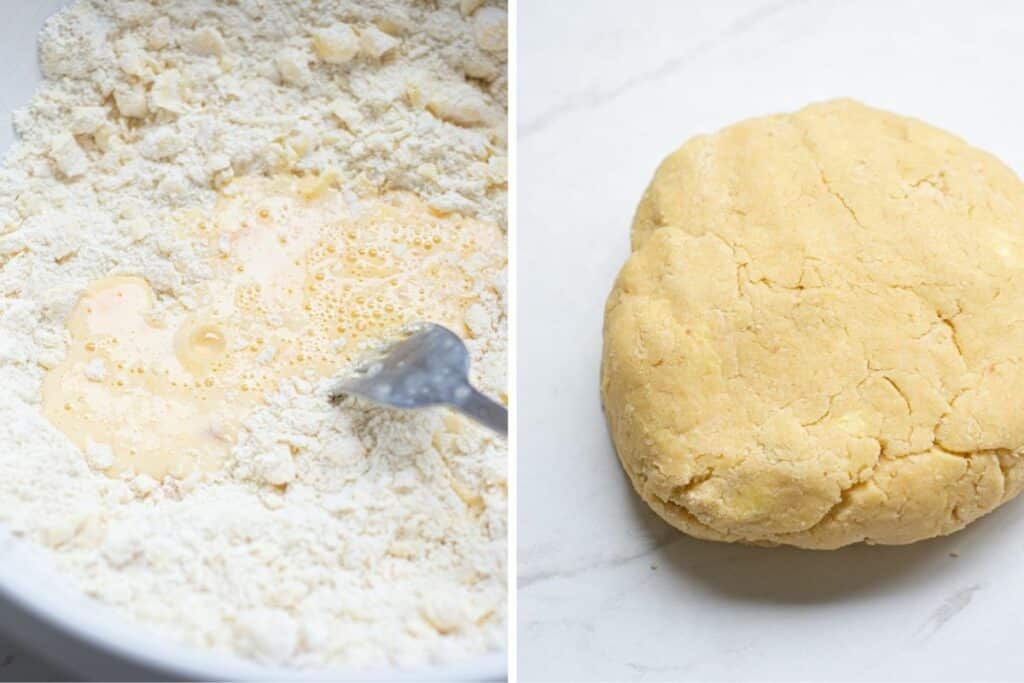
Chilling the pastry
Place the dough into an airtight container and chill it in the fridge for a minimum of ½ an hour until completely cold. Once chilled, roll the dough out on a lightly floured bench into a 12inch/30cm circle.
Dust your rolling pin with flour and roll the pastry around it. Unroll the pastry over a 9inch or 10inch tart tin (23cm or 25cm) and ease it gently into the tin, pressing it into the sides.

Cut off any excess dough at the top and use the excess to patch up any tears in the dough. Use a fork to prick the pastry case bottom. Chill the dough in the fridge again while preheating the oven for blind baking.
Blind baking
Blind baking is the term used for par-baking a tart or pie crust while holding the crust down with baking weights. This stops the unfilled pastry case from puffing up in the oven.
Baking weights can be purchased, or you can use dried beans or uncooked rice to hold down the pastry. First, lay on a sheet of parchment paper so the weights don’t stick to the dough, then pour on the baking weights.
The dough is blind baked in a medium-hot oven for only 7-8 minutes, then the weights and parchment paper are removed, and the pastry case is further baked until golden brown.
Blind baking pastry ensures that the pastry is partly or fully cooked before adding in any fillings. This is helpful for tarts that have an uncooked filling or a filling that only requires a little bit of cooking time.
Roasted orange rhubarb
Once filled, this rhubarb tart isn’t baked long in the oven. For this reason, it is important to cook the rhubarb first before adding it to the tart.
Roasting the rhubarb along with sugar, orange zest and juice softens and caramelizes the rhubarb. It also candies the orange peel to add more flavor to the tart. The rhubarb is roasted for around 15 minutes until soft and sticky.
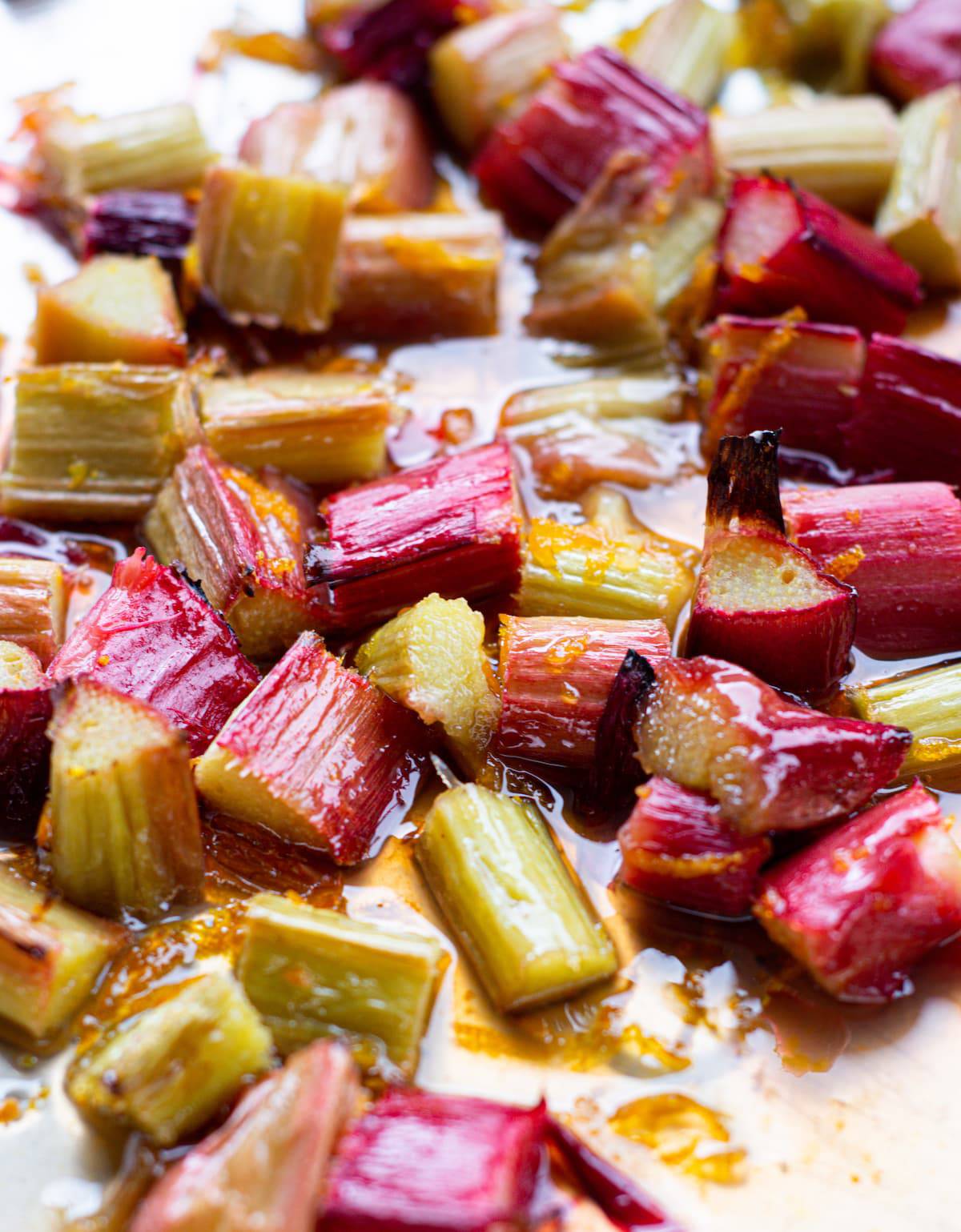
Orange and vanilla Custard
The custard is made with milk, heavy cream, eggs, corn starch, sugar, salt, orange zest, and vanilla paste. It is thick and creamy and full of flavor and compliments the tart rhubarb well.
In a bowl whisk together the eggs, egg yolks, sugar, salt, orange zest and vanilla paste until it’s well combined.
In a saucepan over medium heat, combine the milk and heavy cream. Heat it slowly until almost simmering.
Slowly drizzle the hot mixture into egg mix, whisking as you do so. Slowly drizzling it in will temper the eggs carefully so they don’t scramble.
Once all the hot milk has been incorporated, pour everything back into the saucepan and place it over low-medium heat. Keep whisking and bring the mixture back up to a simmer and let it thicken.
Once thick, pour the hot custard through a sieve to remove any lumps.
Pour the custard into the baked tart shell.
Use a spoon to scoop up pieces of the baked rhubarb, leaving behind the liquid, and arrange the pieces over the custard.
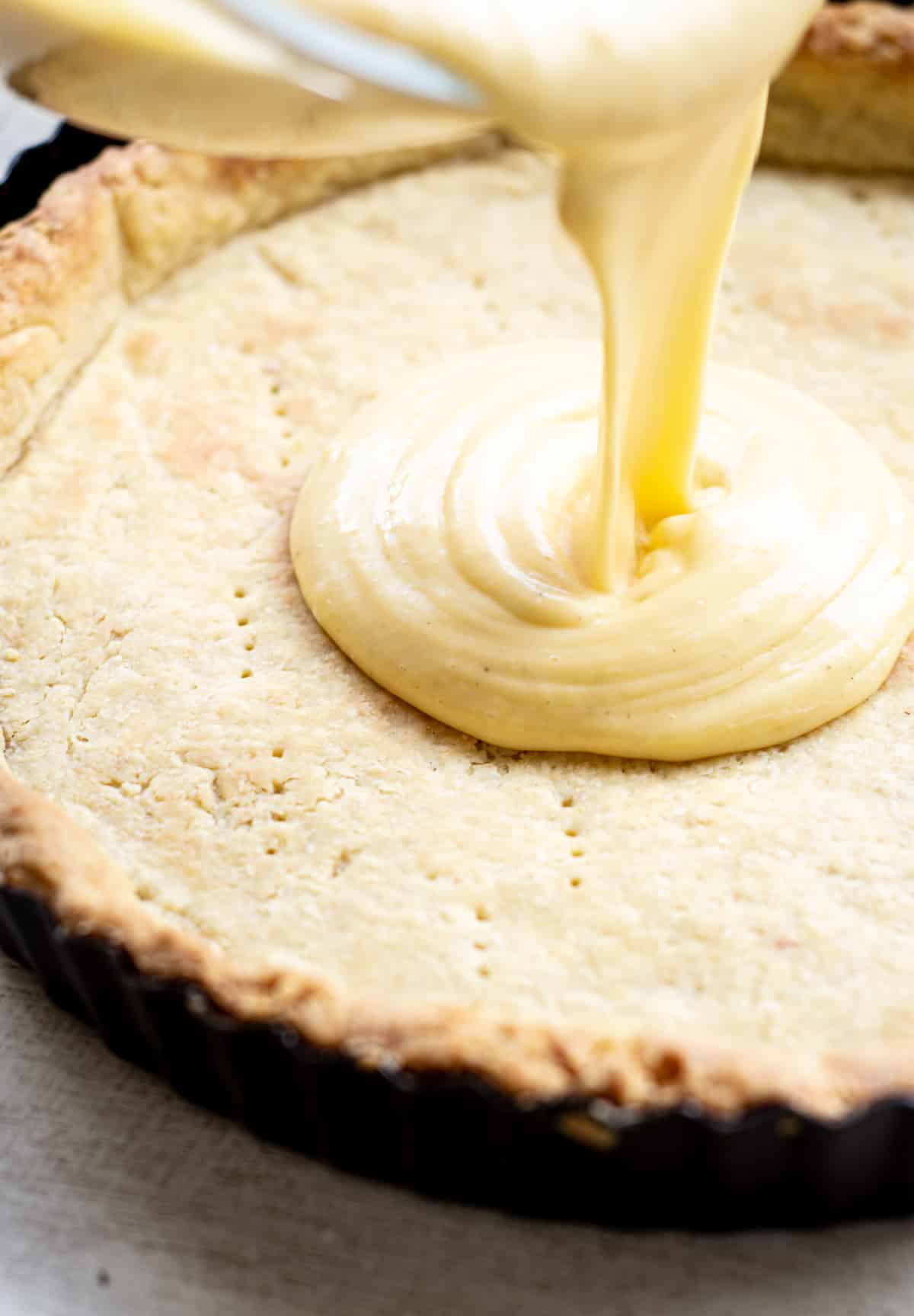

Baking
Place the tart in the oven and bake for around 16-18 minutes. The custard should be set but still, have a wobble to it.
Let the tart cool to room temperature before serving, or chill it in the fridge. The custard will be set the thickest when chilled.
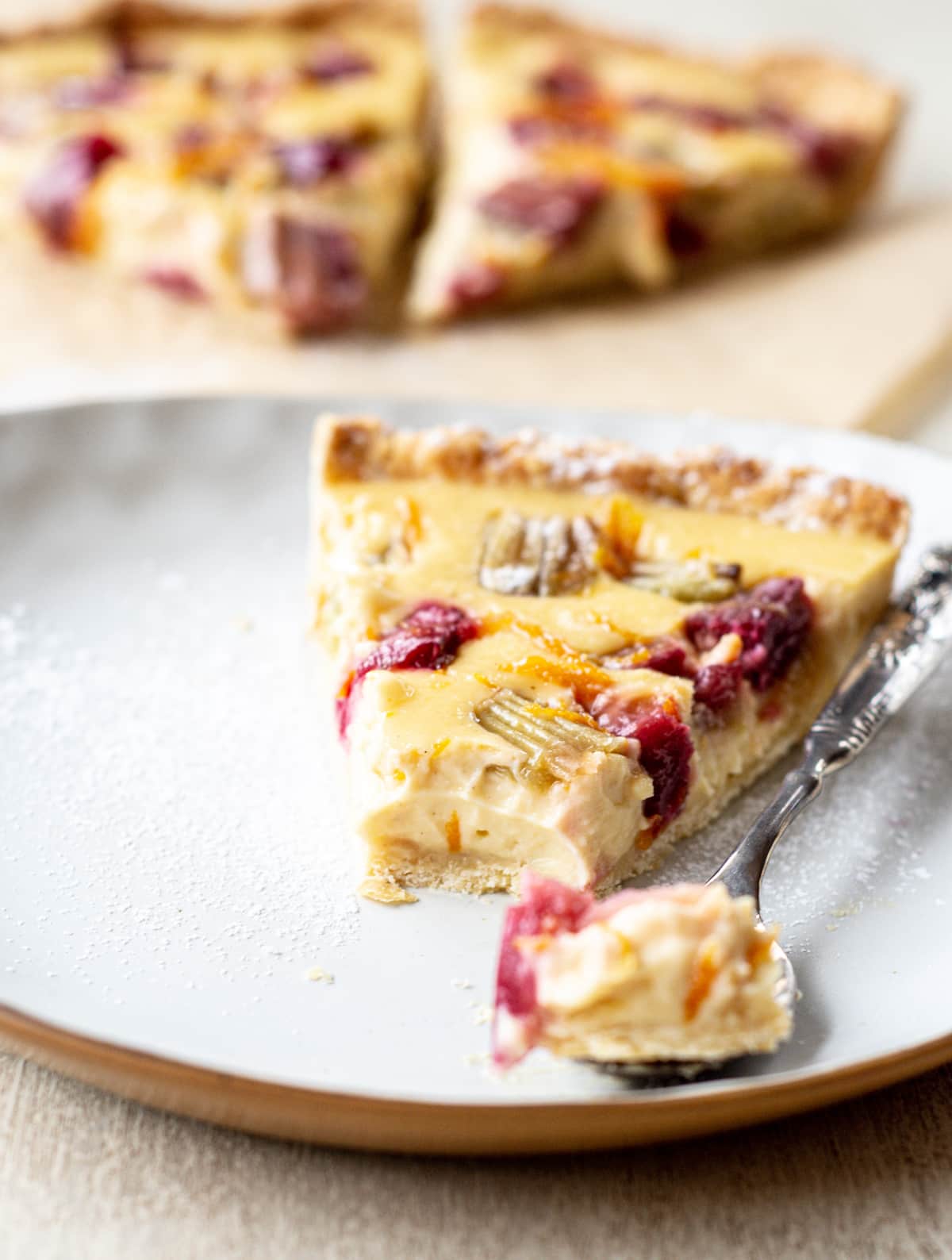
Related Recipes
Want more orange recipes? Try this decadent orange chocolate mousse or orange chocolate cookies.
This rhubarb coffee cake is a great way to use excess rhubarb, or infuse it in gin!
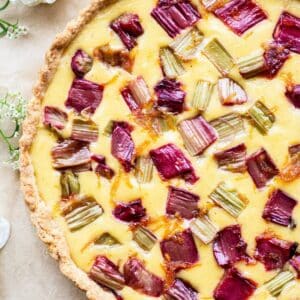
Rhubarb Custard Tart with Orange and Vanilla
Ingredients
Pastry
- 220 g all-purpose or pastry flour
- 30 g powdered sugar
- ¼ tsp salt
- 113 g unsalted butter, cold
- 1 large egg
Rhubarb
- 250 g rhubarb chopped into ½ inch (1 ½ cm) cubes
- 50 g granulated sugar
- Juice of 1 orange
- 1 Tbsp orange zest
Custard
- 240 g heavy cream
- 120 g milk
- 65 g granulated sugar
- 2 large eggs + 2 egg yolks
- 1 ½ Tbsp cornstarch
- 1 Tbsp orange zest
- 1 tsp vanilla paste or extract
- ¼ tsp salt
Instructions
- In a large bowl add the flour, sugar and salt and stir it together. Chop the cold butter into small cubes and add the cubes in. Use a pastry cutter to further cut the butter into the flour, until it resembles coarse bread crumbs. If at any point the butter begins to melt, place the bowl in the fridge or freezer to cool it down.
- In a bowl, lightly whisk the egg. Make a well in the middle of the flour mixture and add in the egg. Use a fork to combine it into a stiff dough. If it is too dry and crumbly add in ½ Tbsp ice cold water as needed. The end dough should hold together but it shouldn’t be wet or sticky.
- Tip the dough onto a lightly floured bench and gently form it into a disc. Don’t over knead it. Place the dough into an airtight container and chill it in the fridge for a minimum of ½ an hour until completely cold.
- Once chilled, roll the dough out on a lightly floured bench into a 12inch/30cm circle. Dust your rolling pin with flour and roll the pastry around it. Unroll the pastry over a 9inch or 10inch tart tin (23cm or 25cm) and ease it gently into the tin, pressing it into the sides.
- Cut off any excess dough at the top and use the excess to patch up any tears in the dough. Use a fork to prick the pastry case bottom. Chill the dough in the fridge again while preheating the oven for blind baking.
- Preheat the oven to 338°F /170°C fan bake or 374°F/ 190°C regular oven.
- Lay on a sheet of parchment paper on top of the pastry. Add on baking weights to hold it down (see notes or above post for details.) Bake the pastry for around 7-8 minutes. Remove it from the oven and remove the parchment paper and baking weights. Bake the pastry for a further 15-18 minutes until golden brown and baked through.
- While the pastry is baking, add the rhubarb, orange juice, zest and sugar to a baking tray. Bake it alongside the pastry for around 15 minutes until softened and sticky.
- In a saucepan over medium heat, combine the milk and heavy cream. Heat it slowly until almost simmering.
- In a bowl whisk together the sugar, eggs and yolk, orange zest, cornstarch, vanilla paste and salt until it’s well combined.
- Slowly drizzle the hot mixture into egg mix, whisking as you do so.
Once all the hot milk has been incorporated, pour everything back into the saucepan and place it over low-medium heat. Keep whisking and bring the mixture back up to a simmer and let it thicken. - Once thick, pour the hot custard through a sieve to remove any lumps, then pour the custard into the baked tart shell.
- Use a spoon to scoop up pieces of the baked rhubarb, leaving behind the liquid, and arrange the pieces over the custard.
- Place the tart back in the oven and bake for around 15-18 minutes. The custard should still have a wobble to it.
- Let the tart cool to room temperature or chill it in the fridge before seving. The custard will set the thickest if it's cooled in the fridge.
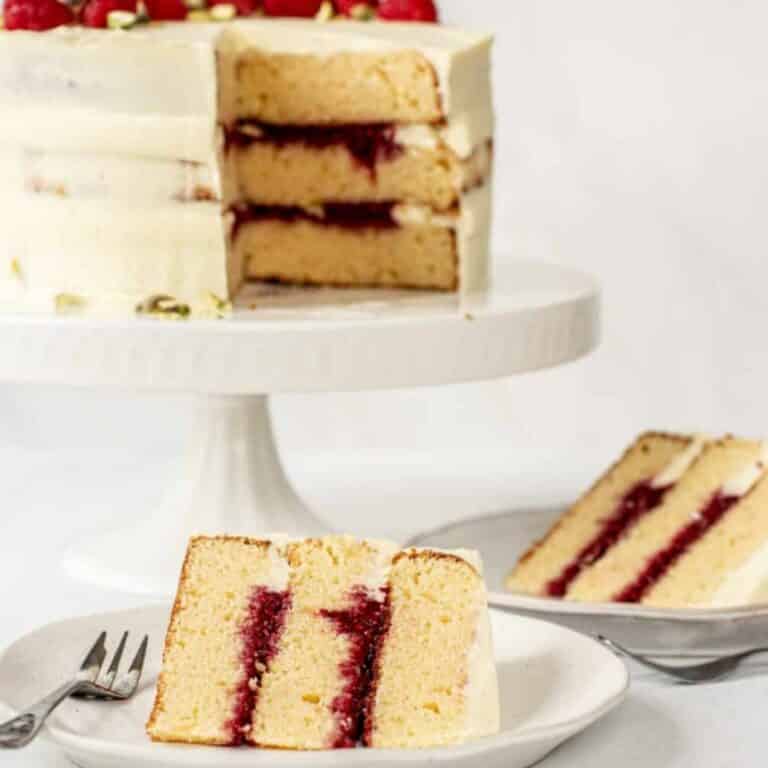


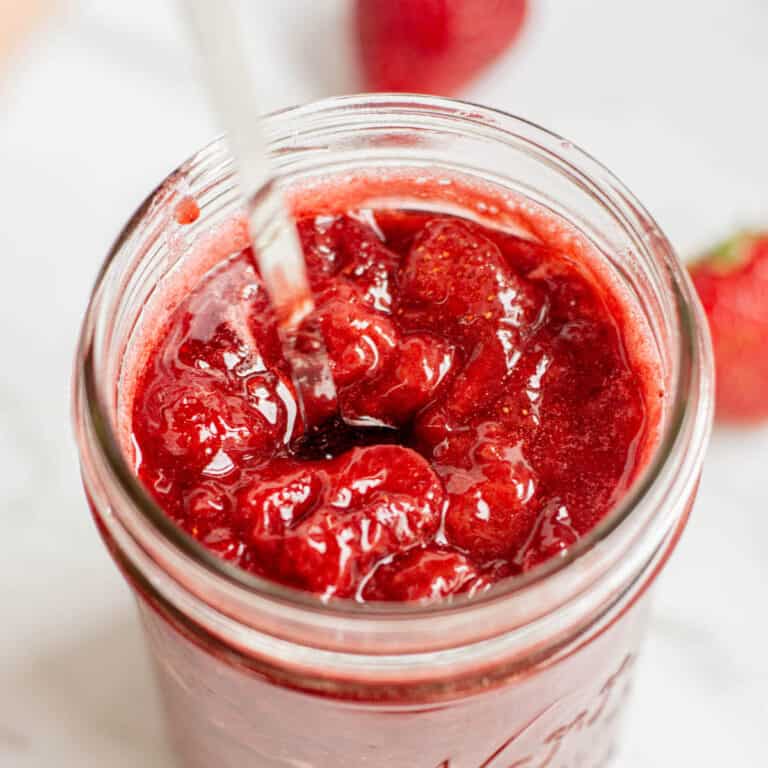
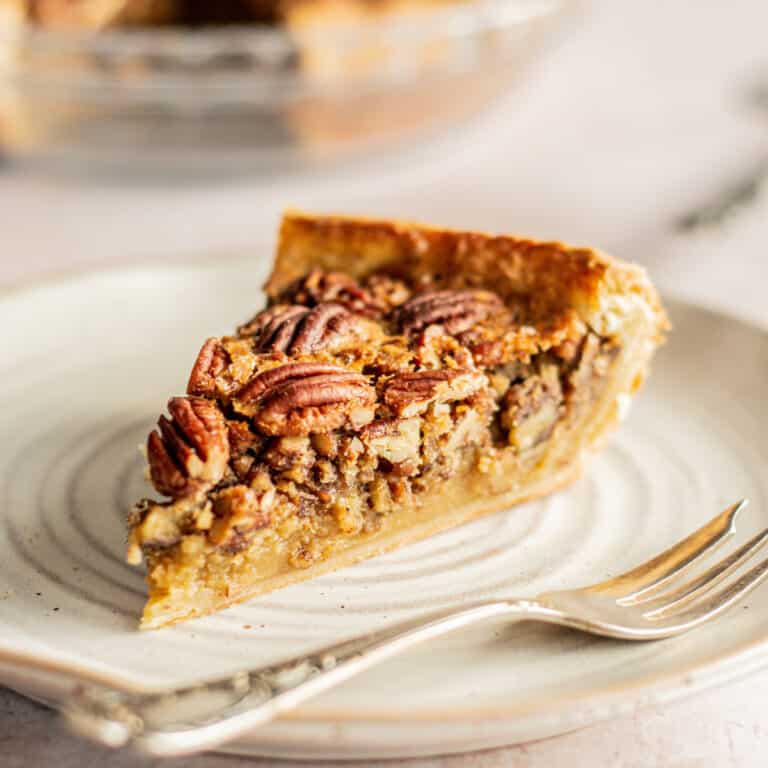
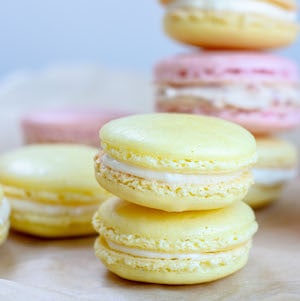
Hi! Can we sub gluten free flour in this recipe?
I’ve not subbed gf flour for this exact one but You can use your favorite gluten free pastry recipe for the base 🙂
Thank you!